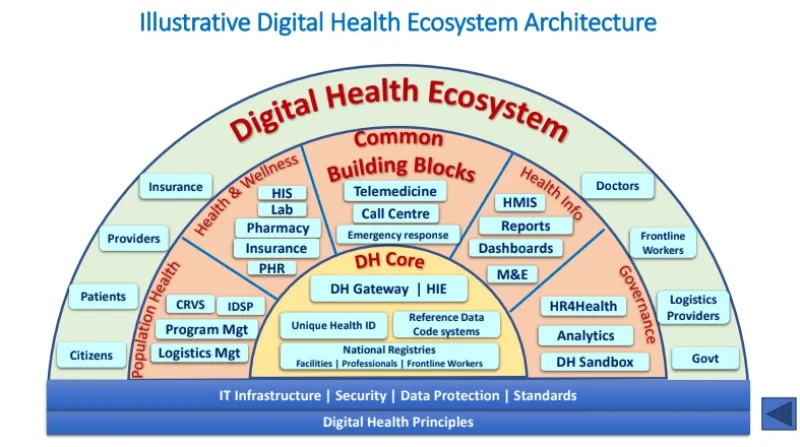Federated Architecture (FA) is a fundamental innovation in digital health that has the potential to alter how healthcare is given and managed, particularly in developing nations such as Bangladesh. FA allows disparate health information systems to be integrated and interoperable while maintaining their autonomy and security. This essay investigates the advantages of FA in the digital health sector and how it can affect the future of healthcare in Bangladesh.
What is Federated Architecture?
Federated Architecture (FA) is an enterprise architecture approach that revolves around the idea of information sharing among semi-autonomous, de-centrally organized entities using various IT systems and applications.
It’s a framework that empowers organizations to operate independently, yet seamlessly collaborate and share information. FA enables the critical requirements of digital health, such as independence, autonomy, and technological flexibility, while ensuring interoperability. This balance is vital in a rapidly evolving healthcare landscape.
What is the Role of FA in Digital Health?
Federated Architecture (FA) is a critical component of Bangladesh’s digital healthcare system, emphasizing autonomy, interoperability, privacy, and patient-centered care. It enables hospitals, clinics, and diagnostic labs to operate independently while exchanging crucial data.
FA’s real-time connectivity simplifies IT system integration, improving patient care quality. It maintains privacy and security safeguards while supporting person-centered health records. FA promotes various health services by fostering partnerships among government, businesses, and nonprofits.
The Building Blocks of Digital Health Architecture
To understand how FA operates within the digital health landscape, it’s essential to explore the core building blocks that form the foundation of this architecture.

Core Building Blocks
Core Building Blocks serve as the heart of the Digital Health Enterprise. They act as a Single Source of Truth and System of Record at the national level, enabling interoperability between various components. These building blocks are created and maintained at the national level by the government.
Unique Health ID: This is an alphanumeric ID issued to every applicant. It is based on a primary ID (e.g., NID, DL, Passport) and is exclusively used for accessing health services. The need for a Unique Health ID arises from the fact that traditional IDs like NID are available to citizens only, while health services should be provided to all residents, including expats and tourists.
Benefits of UHID: UHID offers a range of benefits, including accurate identification, reduction of queues in outpatient services, telemedicine facilitation, and transparent consent management for users.
Healthcare Professionals Registry: A repository of profiles of healthcare professionals and workers. This registry serves to uniquely identify them and authenticate their qualifications to function across multiple systems and institutions.
Health Facilities Registry: This registry contains information on healthcare institutions such as hospitals, clinics, diagnostic labs, and pharmacies. It ensures that all healthcare facilities are registered and regulated.
Unified Health Interface: An open protocol that supports interoperability of digital health services, making it easier for different entities to communicate effectively.
Personal Health Record (PHR): A longitudinal record of health-related information stored, managed, and controlled by an individual, empowering patients with ownership over their health data.
Reference Building Blocks
The Bangladesh Digital Health Mission (BDHM) is a critical component of the digital health landscape. It plays a pivotal role in the implementation of Digital Health Enterprise (DHE) in Bangladesh. The BDHM’s responsibilities include:
- Creating the right Digital Health Transformation Team (DHT).
- Guiding and supporting the government in policy formulation for DHE.
- Developing a detailed Plan of Action for implementing DHE.
- Design, development, and management of core building blocks of DHE, namely, Unique Health ID, Core Registries, Health Information Exchange, and PHR.
- Capacity building across various levels.
- Building the community of digital health and promoting wide adoption of DHE apps.
- Establishing the IT and non-IT infrastructure for DHE.
- Promoting the adoption of health informatics standards.

Indicative Organizational Structure of BDHM: The BDHM’s structure consists of a Governing Body, CEO, and various departments such as Technology, Capacity Building, Operations, Architecture Development Deployment, and more. It is a thin and lean organization guided by a high-level Governing Body and led by a HealthTech expert as CEO.

Why Does DHE Need a Dedicated Institution?
A specialized institution is an ideal option for implementing a Digital Health Enterprise (DHE), a complicated and mission-oriented initiative that involves techno-legal-functional skills. Such an institution may consolidate the talents and competencies needed for DHE and manage the design and development of its key building elements.
It can also cooperate with many agencies to develop the digital health ecosystem and have the flexibility, autonomy, and financial independence to do so efficiently. A focused institution can attract and retain talented people and stay up with the evolving technology. Establishing such an institution is inexpensive in comparison to the value and benefits it gives to stakeholders.
Exploring the Digital Health Ecosystem
Digital health is a complicated ecosystem with several players and components. Patients and citizens are crucial in making educated health decisions, while healthcare providers, doctors, and frontline workers collaborate. Insurance companies handle the financial issues, while logistics companies ensure that medical supplies are timely.

The healthcare industry includes telemedicine, call centers, emergency response services, health information systems, labs, pharmacies, and personal health records. Government agencies oversee and regulate this sector. Population health efforts monitor and manage overall health, while governance ensures the ecosystem runs smoothly and securely.
Overview of 4-level Capacity Building Program
HealthTech Professionals: They ensure that digital health systems and technologies work optimally.
Healthcare Professionals: They use digital health tools to provide patients with high-quality care.
Policy & Administration: They establish the rules and regulations governing digital health and oversee its functioning.
Frontline Health Workers: They use digital health to help them with their daily activities and to provide care to patients.
Each level ensures that individuals and organizations focus on specific areas and equips them with the knowledge and skills necessary to thrive in the digital health landscape.
Implementing Digital Health Architecture
Adopting Digital Health Architecture is a large undertaking that demands careful planning and execution. We have created a three-year strategic action plan to guide this process. Critical milestones in the first year include:
- The formation of important committees.
- The development of architectural frameworks.
- The enhancement of current systems to fit with Digital Health Blueprint (DHB) concepts.

This phase also includes policy development, standard notification, and capacity building for various categories. The second year focuses on launching key building blocks, increasing standards adoption, and integrating telemedicine, all while strengthening the Digital Health Mission (BDHM) organization.
In the third year, the emphasis switches to infrastructure scalability, with the creation of a Health Information Exchange, the creation of common building blocks, and the reinforcement of security and privacy through operations centers. The ultimate goal is to launch an expanded collection of digital health services, assuring Digital Health Architecture’s overall success.
Design Considerations for Digital Health Architecture
In digital health architecture, one should consider legacy systems, scalability, performance, interoperability, and person-controlled health records (PHRs). It should promote coherence without uniformity, withstand strong demands, and perform at a high level.
Interoperability enables the ‘ONCE ONLY’ principle, telemedicine, and a continuous care continuum. PHRs empower individuals while also enhancing service delivery efficiency and democratizing digital health for all.
Conclusion
Bangladesh is on the verge of a digital health revolution, and Federated Architecture (FA) is a crucial enabler of that change. By integrating many data sources and platforms into a single framework, FA enables a more effective, safe, and compatible healthcare system.
The Bangladesh Digital Health Mission is a dedicated entity that oversees the implementation of FA and other digital health projects to improve healthcare quality in the country and worldwide. These efforts will not only enhance people’s health but will also position Bangladesh as a global leader in digital health innovation. FA is the path to a more digital and healthy future.


